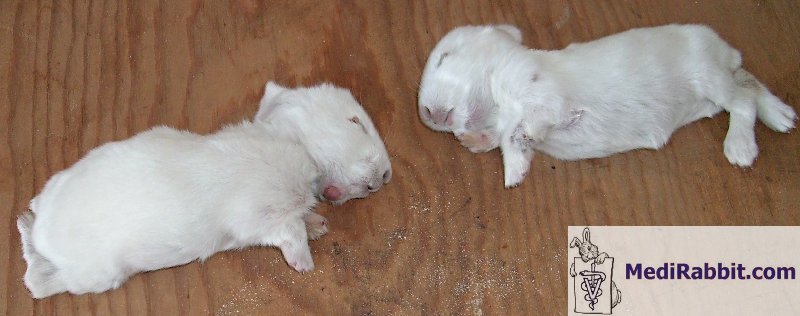Staphylococcosis affecting young rabbits
Michel Gruaz
|
MediRabbit.com is
funded solely by the generosity of donors. Every
donation, no matter what the size, is appreciated and will aid in the
continuing research of medical care and health of rabbits. Thank you |
Warning: this
file contains pictures that may be distressing for people
|
Between 1982
and 1985, an acute form of staphylococcosis infection appeared in rabbit
farms with rational breeding programs. From 1985 to 1990, the disease
decreased thanks to efficient prophylaxis methods. The infectious disease
spread again strongly between 1990 and 1992 with the introduction of
group-housing of rabbits. After bacterial cultures, it was discovered that
the infectious agent was Staphylococcus aureus. Healthy rabbits
can remain asymptomatic carriers of the Staphylococcus sp., with the
bacteria found on the skin or mucous membranes. Affected animals present
various clinical signs, which include skin lesions or small abscesses. The
bacterium can be transmitted to other animals or offspring, from animal to
animal, or through human handling, through bedding (e.g., hay, straw, litter
box filling). Newborn aged between 0 and 15 days are particularly sensitive
to bacterial infection, and the risk contamination is especially high if the
doe is affected. Clinical
signs
General signs are unusual behavior of young female
rabbits, mastitis, the presence of abscesses, dermatitis
and/or pododermatitis, as well as a
high rate of mortality among newborn rabbits. The affected animals must be
isolated. The death rate is high. Preventive measures include a good hygiene and
quarantine of the affected animals, as well as observation and screening with
a clinical examination of the rabbit and bacteriologic tests such as
bacterial cultures and sensitivity tests to antibiotics. Treatment includes
the use of antibiotics. Often they need to be given over a longer period of
time. The administration of SC fluids is indicated in case of
dehydration. Pasteurella multocida is a bacterium that can cause
respiratory problems in rabbits, but also abscesses under the chin, neck, on
the limb, back and uterus, as well as mastitis. Preventive measures include a
clean living environment. Depending on the gravity of the disease, the animal
must be isolated or can be left with its companion rabbit. Treatment includes the administration of systemic antibiotics.
Acknowledgements
Many thanks to Hazel Forrest for sharing the
pictures of the young rabbits and his permission to use in MediRabbit. More Information
Boucher S, Nouaille L. Maladies des
lapins. Paris, F: Editions France Agricole; 2002. Van Praag E,
Maurer A, Saarony T. Skin
Diseases of Rabbits. Geneva, CH: MediRabbit.com; 2010. |
e-mail: info@medirabbit.com




